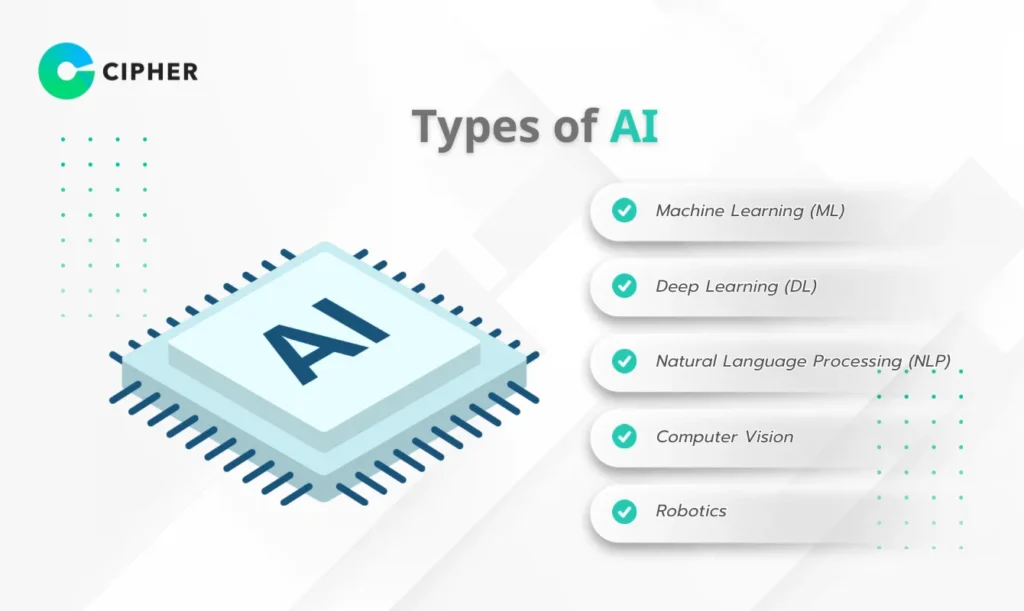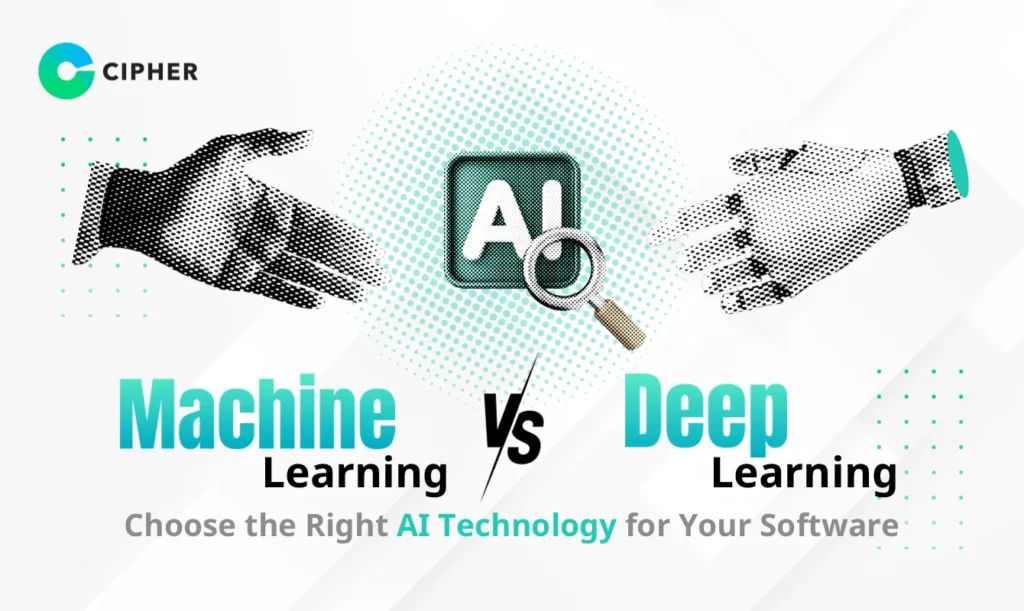Have you ever wondered how Netflix knows what series you should watch next? Or how Facebook recognizes faces in your photos with such accuracy? Or what makes self-driving cars a reality? The answers lie in AI technology, especially Machine Learning and Deep Learning. But between Machine Learning vs Deep Learning, which one would better suit your business needs?
In this article, CIPHER, experts in Software Development and Digital Marketing, will guide you through Machine Learning vs Deep Learning in an easy-to-understand way, explaining how each works, how they differ, and most importantly, which technology you should choose for your business.
Table of Contents
What is AI? The Basics You Should Know Before Understanding Machine Learning and Deep Learning

Before we dive into understanding Machine Learning and Deep Learning, we should first understand what AI is.
AI (Artificial Intelligence) refers to technology that enables computers or machines to mimic human intelligence in learning, analyzing, and decision-making. Today, AI plays a more significant role in our daily lives than we might think, including:
- Virtual Assistants: Like Siri or Alexa, which can answer questions, play music, set alarms, or even control home devices based on your voice commands. They work by converting speech to text, analyzing the meaning, and processing commands with precision.
- Product Recommendation Systems: Online shopping websites use AI to analyze your purchase history, search queries, and browsing behavior to recommend products you might be interested in, making shopping more convenient and encouraging more purchases.
- Spam Filtering: Ever notice how junk emails rarely make it to your main inbox? That’s because AI constantly monitors patterns and content of incoming emails, learning from emails you’ve marked as spam, and filtering out similar ones.
- Weather Forecast Apps: AI helps analyze vast amounts of meteorological data, including atmospheric pressure, temperature, humidity, and other variables, to predict future weather conditions with greater accuracy than traditional calculations.
- Smart Photography Features: Modern smartphones use AI for automatic image adjustments, such as lighting, color correction, or background blurring to mimic expensive DSLR cameras. They can also recognize faces, automatically enhance them, and select the best shot when taking multiple photos in succession.
Types of AI

Machine Learning (ML)
Deep Learning (DL)
Natural Language Processing (NLP)
Natural Language Processing (NLP) processes human language to make it understandable to computers. NLP is a technology that helps computers understand, interpret, and respond to human language, whether spoken or written. This technology enables chatbots, translation systems, and accurate speech-to-text conversion, as well as sentiment analysis from text in social media.
Computer Vision
Robotics
What is Machine Learning? Working Principles and Real-World Applications
Types of Machine Learning
- Supervised Learning: Systems learn from data that already has answers or labels, such as teaching a system to distinguish which image is a dog and which is a cat. In supervised learning, we feed sample data with correct answers to the system. For example, when we want to teach a computer to differentiate between dogs and cats, we input many images labeled “this is a dog” or “this is a cat.” The system learns specific characteristics such as ear shape, nose, or fur texture to create a model that can predict whether a new, unseen image is a dog or a cat.
- Unsupervised Learning: Systems must find patterns or groups in data on their own, without answers to check against, such as segmenting customers by purchasing behavior. In unsupervised learning, we input data without answers or labels and let the system find patterns or structures hidden in the data itself. For example, when we want to segment customers, we might input data on purchasing behavior, purchase frequency, purchase value, and types of products purchased, without specifying which customer should belong to which group. The system will analyze similarities and automatically organize them into groups.
- Reinforcement Learning: Systems learn from the results of actions; if done well, they get rewards; if not, they get penalties, similar to training pets. Reinforcement learning teaches systems to learn through trial and error, with a reward system when correct and penalties when wrong. For example, in teaching AI to play chess, we don’t tell it every step of how to move, but reward it when it wins and penalize it when it loses. The AI gradually learns which strategies lead to victory and automatically improves its gameplay.
Applications of Machine Learning in Real Life
Machine Learning is no longer confined to labs or researcher groups—it’s all around us! Examples of applications you might encounter in daily life include:
- Finance: Detecting abnormal transactions, analyzing credit risk. Banks and financial institutions use Machine Learning to analyze customer spending patterns to immediately detect unusual transactions that might be fraudulent, helping reduce the risk of lending to customers who might not be able to repay.
- Commerce: Recommending products customers might be interested in, analyzing purchasing behavior. Online shopping websites like Amazon or Shopee use Machine Learning to analyze your purchase history, viewed items, searches, or items added to cart to recommend products you’re likely to be interested in.
- Marketing: Customer segmentation, predicting campaign response rates. Marketers use Machine Learning to analyze customer data to segment by behavior, interests, and needs, allowing them to design marketing campaigns that better target specific groups.
- Customer Service: Automated chatbots answering questions, analyzing satisfaction. Many businesses use Machine Learning to develop chatbots that can answer basic customer questions 24 hours a day, reducing staff workload and providing faster customer service.
- Entertainment: Recommending songs or movies you might like. Streaming platforms like Netflix, Spotify, or YouTube use Machine Learning to analyze what you’ve watched or listened to, how long you watched or listened, and what you rated or liked, to recommend new content that matches your taste.
What is Deep Learning? How Does It Differ from Machine Learning?
Deep Learning is a subset of Machine Learning that is more complex, using a structure called “Neural Networks” inspired by the functioning of the human brain. If Machine Learning is like a student learning from examples provided by a teacher, Deep Learning is like a student who not only learns from examples but can also analyze deeply and connect knowledge on their own. What makes Deep Learning stand out is the “depth” of its neural networks, with multiple layers enabling it to learn very complex features, such as:
- Facial Recognition: Deep Learning can analyze facial images in detail, distinguishing specific features like eye shape, nose, mouth, distances between key points on the face, and even characteristics that humans might not notice. This allows it to recognize and distinguish each face accurately, even in different lighting conditions, different angles, or when faces change slightly over time.
- Language Translation: Modern translation systems like Google Translate use Deep Learning to understand the context and meaning of entire sentences, not just word-for-word translation, making translations more natural and accurate. The system understands differences in grammar, idioms, and culture between languages, helping to produce translations of quality closer to professional human translators.
- Medical Image Analysis: In medicine, Deep Learning helps analyze X-rays, MRI images, or CT scans to detect abnormalities with accuracy comparable to specialist physicians. Sometimes it can find small abnormalities that doctors might overlook, enabling faster and more accurate disease diagnosis, resulting in more effective treatment.
- Autonomous Vehicle Driving: Self-driving cars use Deep Learning to analyze images from cameras and various sensors to distinguish objects on the road, whether people, animals, other vehicles, traffic signs, or obstacles. The system can decide whether to accelerate, brake, or turn to ensure maximum safety by processing massive amounts of data in real-time.
Examples you’re familiar with include ChatGPT or Google Bard, which can interact with humans naturally, or apps like DALL-E that create images from descriptions—all of these use Deep Learning technology.
Comparing Machine Learning vs Deep Learning
Machine Learning vs Deep Learning differ in several aspects, including working methods, required resources, and performance in various tasks. Here are the key differences that will help you choose appropriately:
- Structure and Complexity
• Machine Learning: Uses easier-to-understand algorithms such as Decision Trees, Random Forests, SVM
• Deep Learning: Uses multi-layered neural networks, much more complex - Data Requirements
• Machine Learning: Works well even with limited data (about 50-100 data points per feature)
• Deep Learning: Requires massive amounts of data (thousands of data points per feature) to achieve high performance - Processing Resources
• Machine Learning: Uses fewer computing resources; some models can work on ordinary computers
• Deep Learning: Requires high processing power, often needing specialized GPUs or TPUs - Training Time
• Machine Learning: Takes less time, possibly minutes or hours
• Deep Learning: Takes much longer, possibly days, weeks, or months - Explainability
• Machine Learning: Can often explain why it made a particular decision (Explainable AI)
• Deep Learning: Is a “black box” that’s difficult to explain why it produces a particular result - Data Types
• Machine Learning: Suitable for structured data (Structured Data) such as tables
• Deep Learning: Suitable for unstructured data (Unstructured Data) such as images, audio, text
Choosing Between Machine Learning vs Deep Learning
Choose Machine Learning When
You should choose Machine Learning when:
- You have limited data
- You need a model that can explain why it made a particular decision
- You have limited processing resources
- You need to develop a model quickly
- You’re working with clearly structured data, such as customer data or sales data
Example applications:
- Basic product recommendation systems
- Financial risk analysis
- Sales forecasting
- Customer segmentation
- Fraud detection
Choose Deep Learning When
You should choose Deep Learning when:
- You have large amounts of data
- You’re working with complex, unstructured data such as images, audio, or text
- You need maximum accuracy
- You have sufficient processing resources
- You can wait longer for results
Example applications:
- Facial recognition systems
- Natural language processing
- Language translation
- Self-driving cars
- Medical diagnosis from images
Consult and Plan Effective AI Implementation for Your Business with CIPHER
CIPHER Co., Ltd is a leading IT Solution and Digital Marketing company specializing in applying AI technologies, both Machine Learning and Deep Learning, to elevate your business.
We started as a software development company for leading companies in Thailand and have now evolved to become a leader in Online Marketing, as well as a partner with HubSpot, a world-class Online Marketing company.
With experience in managing and developing systems for many leading national brands, including Website, E-Commerce, Application, Online Marketing, Inbound Marketing, Social Media Management, and more, we understand the needs and methods of professional online management across all forms and channels. Our services related to AI technology include:
- Software Development: Developing software using AI technology according to your business needs
- Digital Marketing Consulting: Providing digital marketing consultation using AI technology to analyze and recommend suitable approaches
- E-Commerce Solutions: Developing E-Commerce systems that use Machine Learning to analyze customer behavior and increase sales
- Mobile Application: Developing applications that use AI to enhance efficiency and user experience
- Social Media Marketing & Management: Using AI to analyze social media data to create precise marketing strategies
With our qualified and experienced team, we are ready to consult and plan the effective implementation of AI in your business.
Conclusion
Machine Learning vs Deep Learning are both effective AI technologies, but they have important differences to consider when choosing which to use. The difference between Machine Learning and Deep Learning is not about which is better, but about choosing the right one for the job. In many cases, combining both technologies might yield the best results.
Regardless of which technology you choose, CIPHER is ready to consult and help develop solutions that meet your business needs, with a team of experts and diverse experience working with the country’s leading brands. It’s time to bring AI to enhance your business potential, to stay ahead of competitors in the rapidly changing digital world!
Frequently Asked Questions
How do Machine Learning and Deep Learning differ?
If my organization has limited data, should I use Machine Learning or Deep Learning?
What are some examples of Machine Learning applications in business?
- Product recommendation systems in E-Commerce
- Risk analysis in lending
- Customer segmentation for marketing campaigns
- Automated chatbots in customer service
- Abnormal transaction detection in banking





